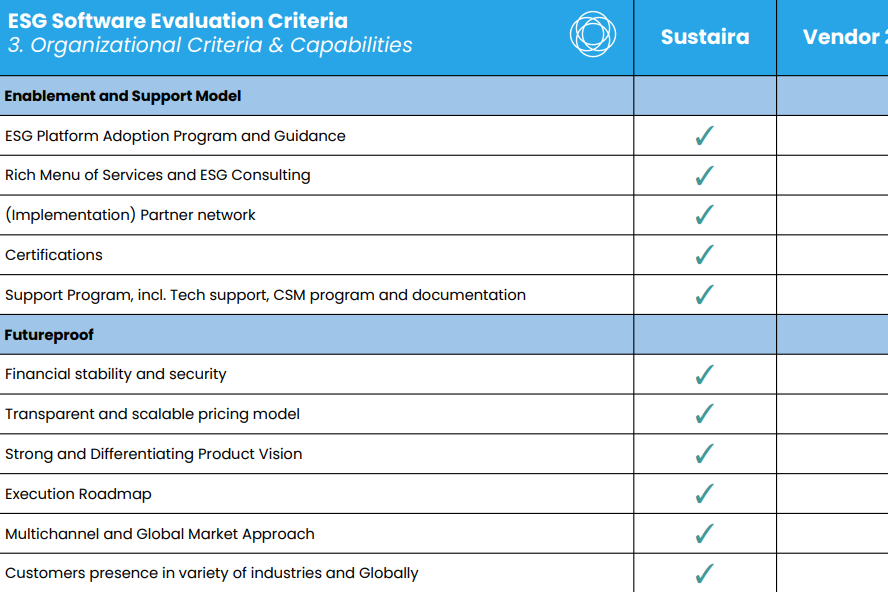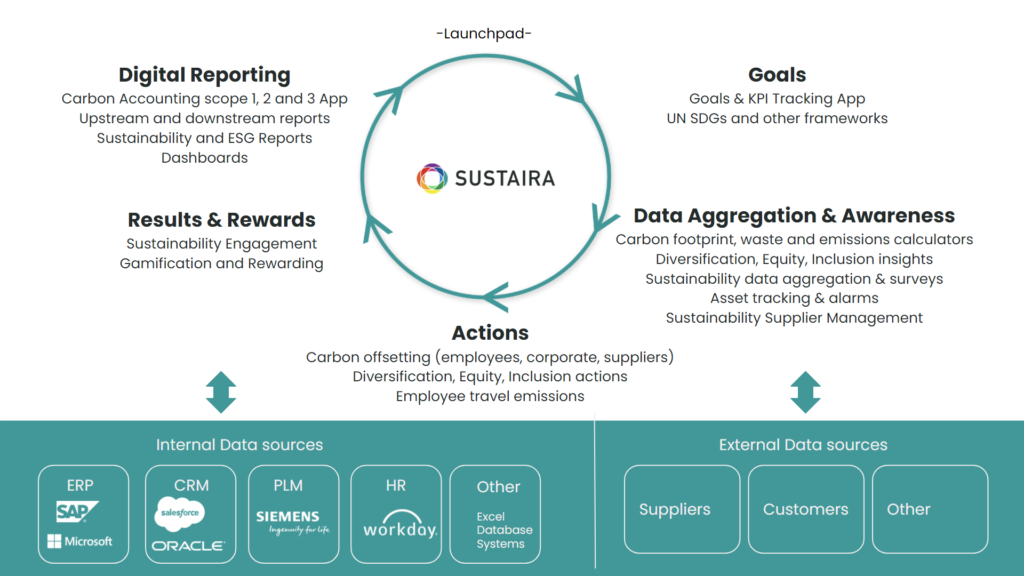Sustaira’s newest guide: Sustainability and ESG software evaluation criteria

We recently released Sustaira’s new Evaluation Criteria Framework for ESG and Sustainability Software. This framework consists of over 60 criteria to enable Sustainability, ESG, Finance and IT leaders to decide which software and platform to adopt for their Sustainability and ESG needs. We have segmented the evaluation criteria into the following three main groups that consist of various subcategories:
- Functional
- Technical
- Organizational
Combining low-code expertise with ESG domain knowledge
Our team has spoken with hundreds of Sustainability and ESG leaders across all industries while working with domain experts and global customers and engaging with leading analyst firms such as Gartner, Forrester and Verdantix. Within these conversations, it’s become evident that with a growing demand for organizations to aggregate, track, measure, and disclose ESG and Sustainability data, combined with the challenges of effectively doing so, people need guidance on where to start when it comes to software. Ultimately, Sustainability and ESG transparency challenges are digital issues that require smart, flexible software as a future-proof solution. Combining our expertise in (low-code) software solutions with ESG domain knowledge is a much-needed value proposition to accelerate Sustainability initiatives. Quickly.
From ‘Profit KPI’ to ‘Purpose-driven KPIs’
At the beginning of our journey here at Sustaira, I wrote our first blog and shared that we firmly believes that organizations will ultimately be held responsible for their impact on the environment and their stakeholders. Gathering data and measuring KPIs will provide transparency to foster accountability. It’s inevitable that change is coming where the profitability is directly impacted by ESG and translated into organizations’ Profit and Loss sheets. This change is a real opportunity to differentiate and to be proactive, demonstrating and proving that actionable Sustainability initiatives offer direct value. This statement, from October 2021, is happening today. We’re moving beyond the “Profit KPI” into “Purpose-driven KPIs.”
As outlined in the formal press release, analyst firms such as Gartner, Verdantix and Forrester all share the same core predictions and expectations; Sustainability and ESG is on top of the priority list for organizations. Firms are officially required to comply with changing regulatory ESG disclosure requirements, including but not limited to the SEC regulations, TCFD, ISSB, CSRD, CDP, GRI and more. What organizations are running into as they prepare is that their current processes and systems are simply not ready, nor sustainable. Pun intended.
Three core ESG and Sustainability challenges
Organizations, at any level of their Sustainability and ESG maturity, share the same core challenges, as internal and external pressure for more transparency grows:
- Sustainability and ESG data is siloed inside and outside the organization
- No easy and efficient way to aggregate and manage the data online
- Too many manual processes and excel spreadsheets: error prone
- Lack of a centralized data hub and single source of truth
- Inefficient reporting internally and externally
- Difficult to demonstrate the impact
- Once a year reporting versus real time and ongoing insights
- Lack of transparency in the supply chain and product-lifecycle
- Inability to turn insights into measurable actions
- No real way to track progress and results based on set goals
- Unable to engage employees around sustainability
- Hard to keep up with constantly changing requirements
Given the above challenges, combined with the timelines mandated by the ESG and Sustainability regulations and global requirements, the need for agile software in this domain is rapidly accelerating.
Evaluation Criteria Framework for ESG and Sustainability Software
To help leaders make an informed decision about which solution to use, we released the core Evaluation Criteria Framework for ESG and Sustainability Software. We have segmented the evaluation criteria into three main groups that consist of various subcategories. Those main groups are: Functional, Technical and Organizational Criteria and Capabilities. Functional criteria and capabilities are considerations regarding features and functionality in the solution itself, such as going beyond Carbon Accounting, ESG data aggregation options and single-view ESG dashboards. Technical criteria and capabilities are technical specifications within the solution itself, such as integrations, customizations and cloud-native architecture and deployment flexibility. Lastly, Organizational criteria and capabilities are considerations regarding the solution provider and its ecosystem, such as an enablement model, (global) partner network and co-creation.
This framework does more than dive into what organizations need to consider in terms of Sustainability and ESG functionality. It tackles technical and organizational subtopics such as multi-tenancy, enablement and support models, internationalization, security and compliance, how future-proof the solution is, integration capabilities and much more. These evaluation criteria are essential to making an informed decision, and the framework is a key tool to use when evaluating and comparing solutions.
Sustaira’s evaluation guide

We also released a comprehensive evaluation guide of its capabilities based on this ESG Evaluation Criteria Framework. Sustaira is uniquely positioned and adopted rapidly by organizations globally, as we:
- Offer a rich and broad ESG portfolio, going beyond Environmental reporting, addressing Social and Governance topics, tackling all elements of the “Sustaira Sustainability Circle.”
- Increase agility and reusability by applying a low-code building-blocks approach for ESG apps, including strong partnerships with Mendix and Siemens.
- Apply an open and collaborative partnership approach, with (local) implementation, ESG/Sustainability consulting, and technical partners.
More in depth information of our evaluation guide can be found here.
Next steps?
In terms of action items, we have a webinar coming up about the Evaluation Criteria Framework for ESG and Sustainability Software as well as the Sustaira capabilities, which I highly recommend. If you can’t attend live, you will get the recording after. See this link for more information and to register.
As we continue to grow and follow our mission, accelerating Sustainability initiatives with innovative web and mobile apps to make organizations more Sustainable, Sustaira truly becomes a 360-degree ESG platform that enables, inspires, and unites everyone in an organization and its ecosystem to make a difference. Follow the journey with Sustaira and learn more:
- Download the Evaluation Criteria Framework for ESG and Sustainability Software
- Get started for free
- Follow us on LinkedIn
- Sign-up for the Sustainability and ESG Insights monthly newsletter
- Contact us directly if you have an interest in our ESG app templates or have ideas for new initiatives.
About the author
Vincent de la Mar is the founder and CEO of Sustaira. He is a hands-on sales leader and entrepreneur with a proven track record and experience in European and North-American markets. After 16 years of experience with the Mendix low-code platform, including bringing this technology from the Netherlands to the U.S. in 2006 and two successful Siemens acquisitions, Vincent launched Sustaira in October 2021.
About Sustaira
Sustaira is the Sustainability and ESG Software Platform for all your web and mobile solutions. As a 360-degree software platform, Sustaira is on a mission to accelerate Sustainability and ESG initiatives by enabling and empowering Sustainability Directors to make their organizations more sustainable. Faster. Sustainability starts with Sustaira.


